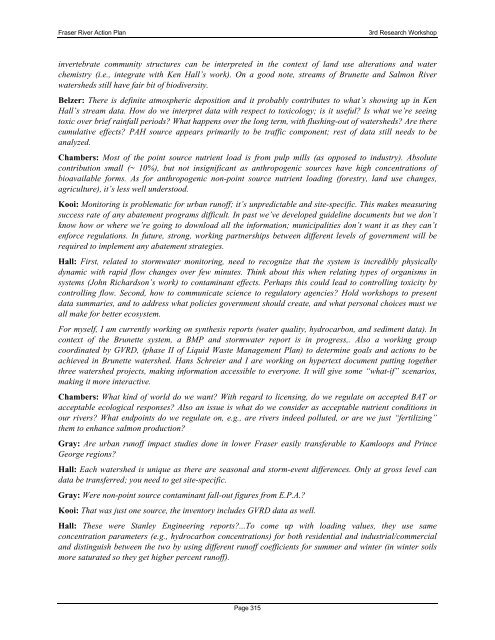Proceedings - Teaching and Learning Centre - Simon Fraser ...
Proceedings - Teaching and Learning Centre - Simon Fraser ...
Proceedings - Teaching and Learning Centre - Simon Fraser ...
You also want an ePaper? Increase the reach of your titles
YUMPU automatically turns print PDFs into web optimized ePapers that Google loves.
<strong>Fraser</strong> River Action Plan 3rd Research Workshop<br />
invertebrate community structures can be interpreted in the context of l<strong>and</strong> use alterations <strong>and</strong> water<br />
chemistry (i.e., integrate with Ken Hall’s work). On a good note, streams of Brunette <strong>and</strong> Salmon River<br />
watersheds still have fair bit of biodiversity.<br />
Belzer: There is definite atmospheric deposition <strong>and</strong> it probably contributes to what’s showing up in Ken<br />
Hall’s stream data. How do we interpret data with respect to toxicology; is it useful? Is what we’re seeing<br />
toxic over brief rainfall periods? What happens over the long term, with flushing-out of watersheds? Are there<br />
cumulative effects? PAH source appears primarily to be traffic component; rest of data still needs to be<br />
analyzed.<br />
Chambers: Most of the point source nutrient load is from pulp mills (as opposed to industry). Absolute<br />
contribution small (~ 10%), but not insignificant as anthropogenic sources have high concentrations of<br />
bioavailable forms. As for anthropogenic non-point source nutrient loading (forestry, l<strong>and</strong> use changes,<br />
agriculture), it’s less well understood.<br />
Kooi: Monitoring is problematic for urban runoff; it’s unpredictable <strong>and</strong> site-specific. This makes measuring<br />
success rate of any abatement programs difficult. In past we’ve developed guideline documents but we don’t<br />
know how or where we’re going to download all the information; municipalities don’t want it as they can’t<br />
enforce regulations. In future, strong, working partnerships between different levels of government will be<br />
required to implement any abatement strategies.<br />
Hall: First, related to stormwater monitoring, need to recognize that the system is incredibly physically<br />
dynamic with rapid flow changes over few minutes. Think about this when relating types of organisms in<br />
systems (John Richardson’s work) to contaminant effects. Perhaps this could lead to controlling toxicity by<br />
controlling flow. Second, how to communicate science to regulatory agencies? Hold workshops to present<br />
data summaries, <strong>and</strong> to address what policies government should create, <strong>and</strong> what personal choices must we<br />
all make for better ecosystem.<br />
For myself, I am currently working on synthesis reports (water quality, hydrocarbon, <strong>and</strong> sediment data). In<br />
context of the Brunette system, a BMP <strong>and</strong> stormwater report is in progress,. Also a working group<br />
coordinated by GVRD, (phase II of Liquid Waste Management Plan) to determine goals <strong>and</strong> actions to be<br />
achieved in Brunette watershed. Hans Schreier <strong>and</strong> I are working on hypertext document putting together<br />
three watershed projects, making information accessible to everyone. It will give some “what-if” scenarios,<br />
making it more interactive.<br />
Chambers: What kind of world do we want? With regard to licensing, do we regulate on accepted BAT or<br />
acceptable ecological responses? Also an issue is what do we consider as acceptable nutrient conditions in<br />
our rivers? What endpoints do we regulate on, e.g., are rivers indeed polluted, or are we just “fertilizing”<br />
them to enhance salmon production?<br />
Gray: Are urban runoff impact studies done in lower <strong>Fraser</strong> easily transferable to Kamloops <strong>and</strong> Prince<br />
George regions?<br />
Hall: Each watershed is unique as there are seasonal <strong>and</strong> storm-event differences. Only at gross level can<br />
data be transferred; you need to get site-specific.<br />
Gray: Were non-point source contaminant fall-out figures from E.P.A.?<br />
Kooi: That was just one source, the inventory includes GVRD data as well.<br />
Hall: These were Stanley Engineering reports?...To come up with loading values, they use same<br />
concentration parameters (e.g., hydrocarbon concentrations) for both residential <strong>and</strong> industrial/commercial<br />
<strong>and</strong> distinguish between the two by using different runoff coefficients for summer <strong>and</strong> winter (in winter soils<br />
more saturated so they get higher percent runoff).<br />
Page 315














